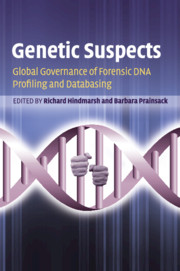Book contents
- Frontmatter
- Contents
- List of contributors
- About the contributors
- Foreword
- Acknowledgements
- 1 Introducing Genetic Suspects
- Section 1 Key areas in DNA profiling and databasing
- Section 2 National contexts of forensic DNA technologies and key issues
- 7 DNA databases and the forensic imaginary
- 8 Partners in crime: the use of forensic DNA technologies in Austria
- 9 Inquisitorial forensic DNA profiling in the Netherlands and the expansion of the forensic genetic body
- 10 DNA the Nor-way: black-boxing the evidence and monopolising the key
- 11 Portuguese forensic DNA database: political enthusiasm, public trust and probable issues in future practice
- 12 On trial! Governing forensic DNA technologies in the USA
- 13 Biosurveillance and biocivic concerns, from ‘truth’ to ‘trust’: the Australian forensic DNA terrain
- 14 Finding the balance: forensic DNA profiling in New Zealand
- 15 Forensic DNA profiling and databasing: the Philippine experience
- Section 3 Conclusions
- Index
- References
11 - Portuguese forensic DNA database: political enthusiasm, public trust and probable issues in future practice
from Section 2 - National contexts of forensic DNA technologies and key issues
Published online by Cambridge University Press: 05 October 2012
- Frontmatter
- Contents
- List of contributors
- About the contributors
- Foreword
- Acknowledgements
- 1 Introducing Genetic Suspects
- Section 1 Key areas in DNA profiling and databasing
- Section 2 National contexts of forensic DNA technologies and key issues
- 7 DNA databases and the forensic imaginary
- 8 Partners in crime: the use of forensic DNA technologies in Austria
- 9 Inquisitorial forensic DNA profiling in the Netherlands and the expansion of the forensic genetic body
- 10 DNA the Nor-way: black-boxing the evidence and monopolising the key
- 11 Portuguese forensic DNA database: political enthusiasm, public trust and probable issues in future practice
- 12 On trial! Governing forensic DNA technologies in the USA
- 13 Biosurveillance and biocivic concerns, from ‘truth’ to ‘trust’: the Australian forensic DNA terrain
- 14 Finding the balance: forensic DNA profiling in New Zealand
- 15 Forensic DNA profiling and databasing: the Philippine experience
- Section 3 Conclusions
- Index
- References
Summary
INTRODUCTION: ESTABLISHMENT OF THE FORENSIC DNA DATABASE
The Portuguese law on the forensic DNA database was established in February 2008 (Law 5/2008) (Government of Portugal 2008). The database is expected to be operational during 2010. The discussion in this chapter is informed by insights obtained from interviews carried out by Machado between March and May 2008 with law and forensic science experts who were part of the committee appointed by the Minister of Justice in January 2006 (Ministry of Justice 2006). The committee had the task of drafting a law regarding a DNA database for civil identification and criminal investigation. The draft law that resulted from the work of this committee was considered by the Portuguese Parliament in September 2007. All translations are by the authors if not indicated otherwise.
The Portuguese Government had already in 2005 announced its intention to create a DNA database for civil and forensic identification purposes. Initially, the intention had been to collect data from the entire Portuguese population. This idea was eventually abandoned in favour of a database restricted to the ‘criminal’ population, as in many other countries in Europe and elsewhere. According to the forensic experts who participated in the preparation of Portuguese law on the forensic DNA database, there were two main reasons why the initial plan to establish a universal database was ultimately abandoned. First, no other country had such a population-wide database.
- Type
- Chapter
- Information
- Genetic SuspectsGlobal Governance of Forensic DNA Profiling and Databasing, pp. 218 - 239Publisher: Cambridge University PressPrint publication year: 2010
References
- 3
- Cited by



